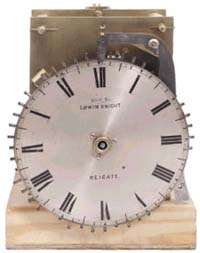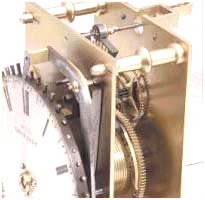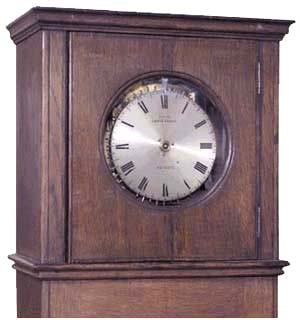|
|
This clock shows the general characteristics of the English "pin clock" that was introduced about 1800 and was still
made, at least occasionally, into the second half of the century. The clocks were made either in the tall case style shown here or in a bracket or shelf-style. The large
disk seen here as the face is rotated by the clockwork and the fixed pointer shows the time of day. When one of the pins on the disk's periphery (spaced the equivalent of 15 minutes apart) moves through the pointer position,
it is beneath the end of a lever. If that lever is actuated by the watchman, the pin is pushed into the edge of the disk, and in that position evidences the watchman's visit to the clock during the corresponding time
period. (There is a fixed cam behind the disk that pushes the pins back to the protruding position before they arrive once again at the registration position 12 hours later.) Development of the pin clocks has
been traced by Paul Harrison in "The Watchman's Tell-Tale Clock, 1800 - 1920." His emphasis is on the social conditions leading to the first use. He explores interesting leads as to the identity of the inventor, but
the record does not allow a definite conclusion. Although Knight worked as late as 1850, this clock is very much like ones produced years earlier and it exhibits the most fundamental weakness of the early pin clocks, namely
the ability of a watchman to hold the lever depressed to intercept one of the pins and thus stop the clock. Whitehurst & Son of Derby and Robert Roskell of Liverpool, to name two makers, had incorporated defenses against this
decades before Knight's time. The general remedy was to mount the lever in a flexible arrangement that allowed it to be pushed out of the way by an intercepted pin. The best embodiment of this came about once the early
makers moved the pins from the periphery positions shown here in the Knight clock to positions in which they stood perpendicular to the face. |
|


